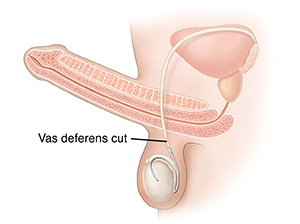Understanding Vasectomy
A vasectomy is a minor surgical procedure that prevents a man from getting a woman pregnant. It's the permanent birth control method that works best for men.
Your reproductive system
For pregnancy to occur, a man’s sperm (male reproductive cells) must join with a woman’s egg. To understand how a vasectomy works, you need to know how sperm are made, stored, and released by the body:
-
The urethra is the tube in the center of the penis. It transports both urine and semen. When you have an orgasm, semen is ejaculated out of the urethra.
-
The seminal vesicles and the prostate gland secrete fluids called semen. This sticky, white fluid helps nourish sperm and carry them along.
-
The epididymis is a coiled tube that holds the sperm while they mature.
-
The scrotum is a pouch of skin that contains the testes.
-
The testes are glands that make sperm and male hormones.
-
The vas deferens are tubes that carry the sperm from the epididymis to the penis.
-
Sperm (shown as a blue arrow) carry genetic material.

How a vasectomy works
During the procedure, the two vas deferens are cut and sealed off. This prevents sperm from traveling from the testes to the penis. It is the only change in your reproductive system. The testes still produce sperm. But since the sperm have nowhere to go, they die and are absorbed by your body. Only a very small amount of semen is made up of sperm. So after a vasectomy, your semen won’t look or feel any different.

A permanent decision
A vasectomy is a permanent form of birth control. Before having this procedure, you must be sure that you don't want to have children in the future. In some cases, it's possible to have a procedure to undo (reverse) the vasectomy; however, not all vasectomies can be reversed. The most effective way to reverse a vasectomy is by microsurgery that is done in a hospital or outpatient surgery center. This procedure is often not covered by insurance.
Keep in mind
After a vasectomy, some active sperm still remain in the reproductive system. It will take at least 3 months or longer and many ejaculations before the semen is completely free of sperm. You shouldn't assume your vasectomy is effective until a semen analysis proves it is. Until then, you’ll need to use another form of birth control.